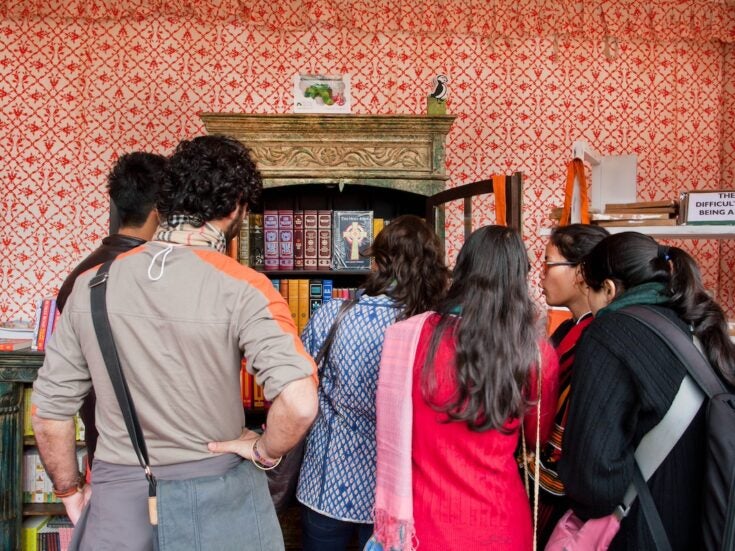
There’s more to digital design than gimmicks and gadgetry — which is why curators and collectors approach it as a form of contemporary art, says Nicole Swengley
THE ANNUAL ART-FEEDING frenzy that turns London into a collecting maelstrom during Frieze Week paused for a reflective moment one evening at Carpenters Workshop Gallery this year. Unveiled in the gallery’s pristine white space was a design whose technological brilliance and emotive, poetic qualities made a clearly captivated audience literally gasp out loud.
Three ethereal cubes, made from slender brass rods illuminated with LEDs, hung from the ceiling. At first glance the design looked like an elegant, contemporary chandelier. Then something extraordinary happened. When people spoke or moved or clapped their hands, suddenly a frisson of light in the shape of a swarm of bees swept through the installation, moving from the first cube to the second and on to the third. The more sound or movement created, the more exuberant the ‘bees’ became. Yet, when you stepped closer, the swarm shyly backed away. The effect was mysterious — magical even — and totally compelling.
Everyone present that evening was intrigued and wanted to know more about the Swarm Light (£105,000) created by rAndom International, one of a new generation of digital design studios whose work is increasingly sought by international collectors and curators. And it wasn’t the studio’s only remarkable design shown during Frieze Week. Over at the Pavilion of Art and Design in Berkeley Square, Carpenters Workshop Gallery exhibited another of rAndom International’s interactive phenomena entitled Self Portrait (£54,000) (below). This wall-hung design initially appeared to be a blank screen. However, as you walked towards it, an image began to appear, momentarily capturing your features and a surprised reaction before fading from view.

The previous version of this design, called Study for a Mirror, was shown earlier this year at the V&A’s ground-breaking show Decode: Digital Design Sensations. Now in the V&A’s permanent collection, it comprised a light-reactive screen print mounted like a mirror. When you stood in front of it your image slowly appeared, as if painted with light, then faded away into a mirrored surface. Like other digital designs in the show it required an audience to bring it alive. And this is what intrigues a small but growing band of collectors who find they can, quite literally, become part of an artwork itself.
THE DECODE SHOW attracted 95,000 visitors and introduced contemporary digital designs to a wider audience beyond the collecting arena. It also proved ‘a good time to look at our programming for digital design’, says the V&A’s deputy head of contemporary programmes, Louise Shannon, who co-curated the show. ‘Although the museum has collected computer-generated work since the 1960s, the Decode exhibition and the acquisition of rAndom International’s work marked the V&A’s embrace of the radical possibilities of new design technologies. We’re building the infrastructure to increase our collection of digital work because it reflects what’s going on in contemporary design.’
The V&A is not alone in espousing digital design. New York’s Museum of Modern Art has Dutch designer Simon Heijdens’ Lightweeds, Dunne & Raby’s robots and work by John Maeda and Troika in its permanent collection. And several of London-based Moritz Waldemeyer’s digital designs have featured in museum exhibitions, most notably the Pong table in MoMA’s Design & the Elastic Mind and the Joyrider light at Design Museum Holon’s inaugural show in Israel.
Meanwhile, a new piece by Heijdens called Shade was commissioned by the Art Institute of Chicago for its Hyper-Links: Architecture & Design show, which runs until July 2011. After that it will become part of the museum’s permanent collection, which includes Stefan Sagmeister’s interactive piece Being Not Truthful Always Works Against Me and Maarten Baas’s Sweepers Clock (from his Time project). ‘We are not deterred by a project because it is digitally based,’ says Zoë Ryan, Neville Bryan Curator of Design at the Art Institute of Chicago. ‘When we believe a project to be so inventive and an exceptional example of new thinking and practice, it just prompts us to work harder in ensuring good care and maintaining the appropriate equipment and updating when necessary.’

Curatorial endorsement from international museums is increasingly giving collectors the confidence to purchase digital designs for themselves. Along with the realisation that digital technology is just as much a material for creating objects as wood or steel comes an acknowledgment of its importance as a historic signifier of its time. The experiential familiarity we all have with technological developments through the use of personal computers underpins this instinct. There’s another influential aspect, too.
‘Younger collectors feel comfortable buying into digital design partly because it requires no prior art or design knowledge,’ observes Subhas Kim Kandasamy of Carpenters Workshop Gallery.
Still, some collectors are both knowledgeable and passionate about the work. Rachel Verghis, a collector and former banker who now runs Incubator, a creative platform that helps develop new media works through funding, commissioning and displaying, keeps the first edition of each Incubator- generated design and recently bought four of rAndom International’s designs — Self Portrait, Kinetic Chandelier, Swarm Light and Temporary Graffiti. ‘I’m very keen to have work that’s representative of what is being produced in 2010,’ she says. ‘I see myself still living with these pieces in 40 to 50 years’ time. I love them and consider them as fine art.’
‘These collectable designs are emblematic of a particular moment in time as well as fun pieces of furniture,’ says London gallerist Rabih Hage, who has introduced collectors to technologically advanced designs such as Assa Ashuach’s AI Light (£30,000), which changes shape in response to sound and movement, Waldemeyer’s interactive Roulette dining table (£25,000) and Matali Crasset’s Another Logic of… Eating table (with four chairs and stools, £22,000), whose overhead chandelier (£23,000) moodily changes colour according to the colour of food below it.
‘People appreciate the intelligence of these designs,’ says Hage. This view is shared by gallerist Libby Sellers. ‘A real maestro pushes the technology beyond its obvious ends and that’s what appeals to people,’ she says, citing Heijdens’s Branches, which was shown by Gallery Libby Sellers at Design Miami/Basel and during London Design Festival. This interactive ceiling canopy visibly grows, via bespoke software and sensors, in response to externally monitored data such as human movement and outdoor weather conditions (from £22,000). With all the technical elements of the design gathered into one unit and wirelessly connected to outdoor sensors, it’s well-suited for installation in a private residence and is a richly poetic example of a technology-based design that’s both user-friendly and wildly captivating.
This engagement with technology-led designs is a trend that seems likely to persist. ‘I think digital media will have a much more physical presence in the future,’ says Hannes Koch of rAndom International. ‘Lighting could be activated by gesture-recognition with a space “reading” your body movements, for example.’ It’s a way, he believes, of ‘bringing body and soul into technology and putting a smile on people’s faces’.
THERE’S NO DOUBT that collectors find the combination of an interactive experience and digital artwork irresistible. You only had to watch the fascinated response as people encountered Daniel Brown’s design On Growth & Form, commissioned by the V&A for the Decode show, to understand its impact. The animated ‘wallpaper’ — a light projection activated by self-generative computer software — evolved organically over a wall with flowers spreading, blossoming and fading before one’s eyes. Brown has subsequently developed Secret Garden (from £14,500), a design whose software programme captures a viewer’s image and surrounds it with an animated field of digital flowers. Technologically clever, it’s also sensuous and compelling.

So are collectors buying digital designs purely for their aesthetics, or as sound financial investments, too? Jamie Zigelbaum of US-based digital design studio Zigelbaum & Coelho believes that ‘collectors are buying our work for both financial and aesthetic reasons. From a financial perspective, digital media has only recently found viable narratives for the collectable design and contemporary art markets. Some collectors are very tuned into this. They want to be close to the ideas and part of something new.’
It certainly seemed that way at Design Miami/Basel, where Zigelbaum & Coelho’s interactive lighting installation Six-Forty by Four-Eighty was creating a buzz among collectors — particularly when anyone touching one of the computerised, brightly lit, magnetically wall-mounted tiles found that its colour flipped to another tile via the user’s body. It felt like magic. With advanced computer wizardry attracting collectors looking for the latest technology-led designs, it’s no surprise that only three of the eight editions remain available for purchase (price on request).
Just as digital technology is shaking up the scientific world, so it is revolutionising design thinking. And, with a new generation of designers and studios swinging away from creating tangible, three-dimensional objects towards digitally produced designs, this new and exciting arena is already seducing savvy, switched-on collectors.







